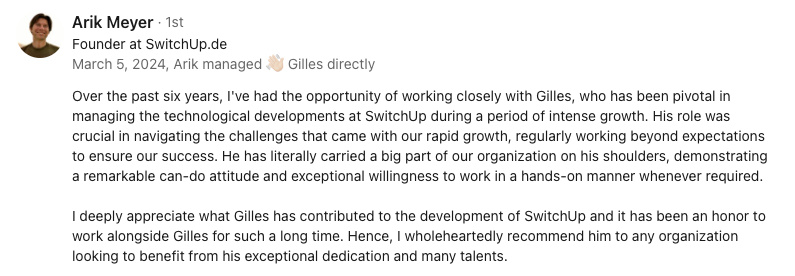Merriam Webster
Abstract:
Merriam-Webster's dictionary has been a crucial resource for the Chief Technology Officer (CTO) in navigating the technology sphere. Its linguistic precision has been valuable for drafting technical documentation, ensuring clear communication, and keeping pace with evolving tech vocabularies. Furthermore, the dictionary serves as an educational tool, aiding in explaining complex concepts and promoting accessibility, especially through its transition to an online resource. The CTO emphasizes that the intersection of language and technology is fundamental for effective communication in the tech industry, highlighting Merriam-Webster's role as an essential companion for a CTO equipped with an up-to-date linguistic toolkit.
importance of Merriam-Webster's dictionary in the tech industry
Merriam-Webster's dictionary might seem like an unexpected hero in the tech industry, but trust me, it's a vital resource. As a Chief Technology Officer, I find that clear communication is one of the most important parts of my job. This is where Merriam-Webster steps in, offering precise definitions that help ensure everyone is on the same page. From drafting technical documentation to explaining complex concepts to stakeholders, having a reliable dictionary at hand is indispensable. It's an unsung hero, gracefully keeping up with evolving tech terminologies and ensuring that we techies don't get lost in translation. After all, understanding whether we mean "data," "datum," or "big data" can make or break a project!
While it doesn't boast sleek hardware or cutting-edge software, Merriam-Webster enhances our technological dialogue and helps bridge the gap between technical jargon and everyday language. And let's be honest, nothing quite beats the satisfaction of correcting someone's misuse of "affect" versus "effect" with confident, dictionary-backed authority!
drafting technical documentation with linguistic precision
When it comes to drafting technical documentation, linguistic precision can be the fine line between clarity and confusion. Merriam-Webster becomes an invaluable ally in this task. In my role as a CTO, I've encountered numerous instances where even a single ambiguous term could lead to misinterpretations and missteps. Technical documentation needs to be as clear as the difference between "histogram" and "bar chart"—both vital, but distinctly different!
Imagine drafting specifications for a software project. Words such as "bind," "compile," or "instantiate" have highly specific meanings. It's crucial that these terms are used correctly to ensure there are no misunderstandings among developers, project managers, or any other stakeholders. Merriam-Webster’s clear definitions can help us avoid any potential pitfalls. By consulting the dictionary, I can ensure that every term is accurately represented and that the documentation flows seamlessly, without any linguistic hiccups.
the role of precision in technical documents
Technical documentation, whether it's API guides, system requirements, or user manuals, should be precise and free from ambiguities. It's not just about using the right jargon, but also about ensuring that every stakeholder can comprehend the document. Here are some key aspects where Merriam-Webster helps:
- Consistency: Using Merriam-Webster helps maintain consistency in terminology throughout the document. This is especially important in extensive projects where the same term might appear multiple times.
- Clarity: By providing clear definitions, Merriam-Webster aids in clarifying terms that might otherwise be misunderstood. For instance, distinguishing between "authentication" and "authorization" can save a lot of headaches down the line.
- Accuracy: Ensuring that terms are accurately defined and used correctly helps in maintaining the integrity of technical communication. This avoids miscommunication and potential project delays.
keeping it engaging
Let's be honest: technical documents are hardly the most thrilling reads. However, using precise language can make them much more manageable. As someone who spends a fair amount of time ensuring that our documentation is up to par, I find that adding a sprinkle of humor can break the monotony. Imagine a sentence like: "Ensure the server is running to avoid an awkward silence during the data transmission." It's not only accurate but also a little entertaining.
In conclusion, Merriam-Webster is an unsung hero in drafting clear, precise technical documentation. By helping us cut through the jargon and ensuring that everyone is speaking the same language, the dictionary becomes an essential tool in the CTO's toolkit. And who doesn't enjoy the smug satisfaction of knowing they're using "complement" and "compliment" correctly?
educational tool for explaining complex concepts
One of the most fulfilling aspects of my role as a CTO is its educational component. From mentoring junior engineers to explaining sophisticated technological concepts to non-technical stakeholders, I find that a reliable source like Merriam-Webster can be a lifesaver. It provides the linguistic tools necessary to break down these complexities into digestible pieces, allowing everyone to be on the same page.
In the fast-paced tech industry, jargon can often create a barrier to understanding. Words like "encryption," "algorithm," or "machine learning" can sound like Greek to some. Here’s where Merriam-Webster comes to the rescue. By offering clear, concise definitions, the dictionary enables me to translate these high-level concepts into plain language. This is crucial when you're trying to ensure that everyone, from the marketing team to the board of directors, grasps the essence of what’s being discussed.
elucidating the enigmatic
Think about those times when you have to explain to a client why a particular feature will take weeks instead of days. The terms "refactoring," "technical debt," and "scalability" often come into play. Using Merriam-Webster, I can define these terms in a way that paints a vivid picture. For example, "technical debt" can be likened to a credit card debt—easy to accrue, but the interest will get you eventually! This analogy, backed by the definition, makes the concept far easier to understand and more relatable.
key benefits of linguistic precision
There are several advantages to using Merriam-Webster in educational aspects:
- Clarity: Clear definitions enable better comprehension of complex terms, aiding in effective communication across diverse teams.
- Engagement: Precise language ensures that explanations are not only accurate but also engaging, making learning a bit more enjoyable.
- Accessibility: Simplifying complex terminology makes the information more accessible to non-techies, promoting inclusivity and collaboration.
adding a dash of humor
Tech concepts can be intimidating, but a little humor goes a long way. When explaining something intricate, a well-placed joke or an amusing analogy can make the information more palatable. For instance, equating the behavior of a stubborn piece of code to that of a rebellious teenager can give everyone a chuckle while subtly driving the point home.
Ultimately, Merriam-Webster is like a trusty sidekick helping me translate the arcane language of tech into something understandable for all. Whether I need to clarify the difference between "latency" and "throughput" or demystify the nuances of "cloud-native" applications, the dictionary ensures my explanations are always on point. So, the next time someone asks you to "debug a neural network," remember, there’s a fantastic glossary just a click away!
transition to an online resource
With Merriam-Webster’s move to an online format, the dictionary has successfully transformed itself into a dynamic and accessible tool for tech professionals like myself. The transition to a digital platform means that I no longer have to haul around a hefty book or even locate one amid the clutter on my desk. Instead, a quick search is all it takes to find the exact term I need, whenever and wherever I need it.
This shift to an online resource has made Merriam-Webster incredibly accessible. Whether I’m on a conference call, in a meeting, or simply working on a document, I can pull up the website or app in seconds. It’s like having a personal linguistic assistant at my fingertips, ensuring that I can maintain the highest level of accuracy and precision in all communications.
keeping up with the latest terms
One of the major benefits of Merriam-Webster being online is its ability to stay updated with the latest linguistic and technological terms. The tech industry evolves faster than you can say "quantum computing," and staying current is crucial for accurate communication. Merriam-Webster continuously updates its database to include new words, phrases, and definitions. This is especially valuable for a CTO who needs to stay on top of new developments and convey these innovations clearly to both technical and non-technical stakeholders.
- Real-time updates: With an online platform, updates can be rolled out quickly, ensuring that we’re never out of the loop on new terminologies.
- Searchability: The convenience of a search function means no more flipping through pages. It's efficiency at its finest.
- Cross-referencing: Online dictionaries often include hyperlinks to related terms, making it easier to understand the broader context of a particular concept.
empowering technology leaders
For a CTO, the need for precise and contemporary language can’t be overstated. Merriam-Webster’s online resource supports this requirement by providing precise definitions that are constantly refreshed to include the latest terminology. This is invaluable when developing technical documentation, making presentations, or discussing project plans with diverse teams. I can confidently explain why our "distributed ledger technology" is revolutionary without worrying that someone might think I’m talking about a new type of furniture.
In all seriousness, the move to an online format has made Merriam-Webster an even more effective tool for anyone in the tech industry. It’s like having a modern-day oracle, ready to resolve any linguistic uncertainty that comes my way. Plus, the sheer convenience is something I wouldn’t trade for the world – or even the heaviest, most comprehensive hardcopy dictionary out there!
intersection of language and technology for effective communication
Language and technology need to get along swimmingly for effective communication—think of it as a perfect symbiosis. As a CTO, I've learned that this intersection is not just fundamental but indispensable. In my day-to-day functions, Merriam-Webster is my go-to linguistic toolkit, helping me navigate the labyrinthine tech jargon with ease. It’s much like having a multilingual interpreter who’s fluent in both "geek speak" and plain English.
Effective communication hinges on the accurate and consistent use of terminology. In the tech industry, where even a slight misunderstand can result in major pitfalls, this becomes ever so crucial. Enter Merriam-Webster, the unsung hero bridging the gap between the complex and the comprehensible. When I’m explaining a new feature to my team, the last thing I want is for "latency" to be mistaken for "lag," or "iteration" for "recursion." Thankfully, a quick lookup can clear things up instantaneously, preventing any potential miscommunications.
importance of a linguistic toolkit
Merriam-Webster serves as an excellent linguistic toolkit for me and my team. Here's how:
- Precision: Technical terms often carry specific connotations. Using precise definitions from Merriam-Webster ensures that terms like "virtualization" and "containerization" are used correctly in their proper contexts.
- Clarity: Clear communication travels farther. With Merriam-Webster, the definitions are not just accurate but also easily understandable for everyone on the team, from the seasoned developer to the new intern.
- Consistency: Ever had someone on your team use "backup" and "archive" interchangeably? Merriam-Webster helps maintain consistent terminology, ensuring that every term is used correctly throughout project documentation and discussions.
the CTO's secret weapon
Imagine a project meeting where I'm trying to describe why our "blockchain" solution is more efficient than traditional databases. Without clear definitions, the conversation can quickly go off-track. Merriam-Webster allows me to concisely articulate these concepts while ensuring everyone understands the nuances. It’s like having an on-demand translation service that helps convert jargon into plain language, making it easier to gain buy-in from diverse stakeholders.
Humor can also sneak its way into the conversations. For instance, I once explained the concept of a "container" by comparing it to Russian nesting dolls—each container housing another. This was followed by Merriam-Webster’s precise definition. It not only elicited chuckles but also cemented the understanding of the concept.
In the end, Merriam-Webster is like the trusty sidekick a CTO needs. It ensures seamless and effective communication within the tech industry, making convoluted concepts accessible and ensuring that everyone, regardless of their tech-savviness, gets the message loud and clear.
CTO's perspective on Merriam-Webster's role
As a CTO, Merriam-Webster is like that unsung hero in my daily toolkit, always there to ensure that linguistic precision and clarity shine through. In the high-stakes environment of technology, where the accuracy of terms can make or break a project, Merriam-Webster is indispensable. It's the safety net catching those inevitable slips in language that could lead to misinterpretations.
Take, for example, those notorious all-hands meetings. You know, the ones where the entire company, from the intern to the CEO, shows up, and inevitably, someone asks, "What exactly does 'refactoring' mean?" Cue Merriam-Webster. I can whip out a precise, concise definition that everyone can understand. It's these moments where the dictionary proves invaluable, taking complex jargon and making it accessible to all.
anecdotes and real-life examples
Let me share a couple of anecdotes that highlight Merriam-Webster's importance from a CTO's point of view:
- Decoding jargon in client meetings: Once, during a client meeting, we were deep into discussing "latency" and "bandwidth." I noticed the clients' eyes glazing over. A quick reference to Merriam-Webster allowed me to articulate these terms in simpler language. The clients left the meeting not just relieved but actually understanding the challenges we were discussing.
- Team alignment: In a previous project, our team had varied interpretations of "virtualization" versus "containerization." A swift Merriam-Webster lookup cleared the confusion and realigned our efforts. It was a silent yet powerful victory against potential project delays.
quotes from fellow CTOs
I’m not alone in valuing this resource. Fellow CTOs often echo similar sentiments. Jane, a CTO at a fast-growing AI startup, once mentioned, "In the chaos of a sprint, nothing is more grounding than having accurate terms at your disposal. Merriam-Webster is like the calm in the linguistic storm." Or consider Tom, CTO of a cybersecurity firm, who stated, "Explaining 'encryption' to a non-tech executive is no small feat. With Merriam-Webster, it's like having a translation guide at hand. It’s magic!"
Merriam-Webster is the trusty sidekick that ensures our communication is always clear, accurate, and effective. It's more than just a dictionary; it's a guardian of linguistic precision in the ever-evolving world of technology.
final thoughts and lasting impression
Reflecting on the multifaceted role of Merriam-Webster, it’s clear that this linguistic tool is indispensable for a Chief Technology Officer like myself. Its ability to provide clear, concise definitions ensures that everyone, from the most experienced engineer to the newest intern, can communicate effectively and avoid the pitfalls of jargon-filled misunderstandings.
Consider these key points:
- Precision and clarity: Ensuring that our technical documentation is devoid of ambiguity, making complex concepts accessible to all stakeholders.
- Educational value: Facilitating the breakdown of sophisticated technological jargon into understandable language for non-technical team members and clients.
- Accessibility: With its transition to an online platform, Merriam-Webster provides instant access to updated definitions, making it a dynamic tool for tech professionals.
Effective communication is the linchpin of success in the tech industry. When technology meets language, Merriam-Webster stands as a guardian of clarity, ensuring that our conversations are precise, engaging, and understandable. Let’s keep this invaluable resource close at hand, always ready to bridge the gap between technical jargon and everyday language—one term at a time.














